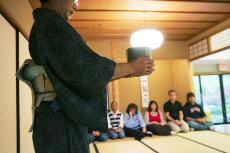Japan House offers peaceful tea ceremony to students
November 29, 2006
Just across from the Vet-Med building, hidden by hills and trees, lies one of the University’s best-kept secrets: the Japan House.
Established in 1998, the 3,130 square-foot facility was designed by Jack Baker, University professor of architecture, with the traditional Japanese tea ceremony in mind. Thanks to large contributions from alumni of the University, the Japan House is proud to display several traditional pieces of Japanese artwork and also to hold the time-honored Japanese tea ceremony, a tradition that began almost 500 years ago.
The Japan house can be summed up in the four words which are used to describe the tea ceremony itself: harmony, respect, purity and tranquility.
Each one of these characteristics can be seen, heard, even felt during the ceremony or around the house, which is the goal of Japan house, said Kimiko Gunji, director of the house and associate professor of Japanese arts and culture.
“(The Japan House) offers a serene and peaceful atmosphere,” she said. “Students and all other visitors savor the serenity in the midst of their busy lives.”
Get The Daily Illini in your inbox!
The traditional tea ceremony does not even begin inside the house.
A participant first begins by walking through the first gardens on the way to the house. These gardens are deciduous and designed to look structured and beautiful. Once at the gates, the observer enters the inner garden. This garden is mainly evergreen flora and built to appear wild and unstructured, right down to the uneven stone path, unorganized to make travelers mind their every step.
In the inner garden lies a small pool of water to wash away and cleanse mind and body in preparation of the ceremony.
“Here the visitor would wait and appreciate the garden until the host approached to guide the guest into the house,” noted volunteer Helen Burch.
When entering the tea room, where the ceremony takes place, it is tradition to stop and appreciate the simple flower arrangement, accompanied by a scroll bearing the meaning of the day, such as “one life, one meaning.” The ceremony is held in silence in order to appreciate every aspect of the tea making.
Each step made is deliberate, each movement carefully planned and every thought focused on the goal of making tea. This ceremony is made to help people fully value life and the little things people take for granted every day.
Kathleen Conlin, dean of FAA, expressed the effect of Japan House as a way to open one’s busy mind.
“The experience of Japan House teaches us to see with new eyes, to breathe in an inner peace, and to extend ourselves to each other in a unique blend of Western traditions and Asian cultural values,” she said.
The ceremony costs $5 and is held every second and fourth Thursday of the month. More of the ceremony and other events that the Japan House holds throughout the year can be found on the Japan House Web site, www.art.uiuc.edu/japanhouse.







